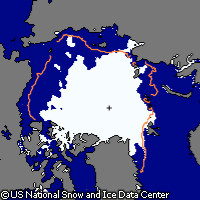Arctic ice possibly heading for all time low
The Arctic ice pack has shrunk to its second lowest level since satellite observations began some 30 years ago, according to new data released by the European Space Agency (ESA) and the US National Snow and Ice Data Center (NSIDC). On 26 August, the Arctic sea ice extent was measured at 5.26 million square kilometres, taking the ice below the 2005 minimum of 5.32 million square kilometres which, until now, was the second lowest ice extent on record. A graph produced by the NSIDC shows that until early August, the ice melted at the same rate as it did back in 2005. However, in 2005 the rate of melting slowed towards the end of the summer. In contrast, this year the ice has continued to melt at a steady pace throughout August. The most recent zones to experience a retreat of the sea ice are the Chukchi Sea off the coast of Alaska and the East Siberian Seas off the cost of eastern Russia. The melt season is not yet over, so the ice will not reach its minimum extent for 2008 until about mid-September. The question now is whether the ice will shrink below the record minimum of 4.28 million square kilometres that was set in 2007. Earlier this year, scientists at the Alfred Wegener Institute (AWI) for Polar and Marine Research in Bremerhaven, Germany predicted that the sea ice would probably reach its second lowest extent this year. Their complex computer model, which drew on a range of sea- and ice-related data taken earlier this year, calculated that the minimum ice extent in 2008 would lie between 4.16 and 4.70 million square kilometres. On the basis of this latest data their forecast looks pretty accurate. 'The polar regions, especially the Arctic, are very sensitive indicators of climate change,' commented AWI's Professor Heinrich Miller. 'The UN's Intergovernmental Panel on Climate Change has shown that these regions are highly vulnerable to rising temperatures and predicted that the Arctic would be virtually ice free in the summer months by 2070. Other scientists claim it could become ice free as early as 2040. Latest satellite observations suggest that the Arctic could be mainly ice free even earlier.' The ongoing retreat of the Arctic ice pack has important implications for navigation and exploration. Recent images from ESA's ENVISAT satellite clearly show that the most direct route through the Northwest Passage, which runs along the top of Canada and provides a shortcut between Europe and Asia, is almost entirely ice free. The Amundsen Northwest Passage, which offers a less direct route, has been passable for almost a month. The AWI's polar research icebreaker, the Polarstern, is currently exploiting the Northwest Passage's ice free status to carry out experiments in the region. 'Departing from Iceland, the route has taken the ship through the Northwest Passage into the Canadian Basin where geophysical and geological studies will be carried out along profiles into the Makarov Basin to study the tectonic history and submarine geology of the central Arctic Ocean,' explained Professor Miller. 'In addition, oceanographic as well as biological studies will be carried out. Polarstern will circumnavigate the whole Arctic Ocean and exit through the Northeast Passage.' Arctic wildlife is also suffering as a result of the disappearance of the sea ice. Recently, US government surveys documented large numbers of polar bears swimming in the open sea, far from land or ice. Although the animals are strong swimmers, they are at risk of drowning if caught in the open water during stormy weather.



